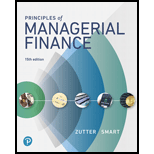
Gitman: Principl Manageri Finance_15 (15th Edition) (What's New in Finance)
15th Edition
ISBN: 9780134476315
Author: Chad J. Zutter, Scott B. Smart
Publisher: PEARSON
expand_more
expand_more
format_list_bulleted
Question
Chapter 1.2, Problem 1.6RQ
Summary Introduction
To discuss: The reason why managers make out that trade-off exists between returns and risk and even the reason why this trade-off exits.
Introduction:
Risk refers to the movement or fluctuation in the value of an investment in the business. The movement can be positive or negative. A positive fluctuation in the price benefits the investor. The investor will lose money if the price movement in negative.
Return is a loss or gain incurred on the investment made by the investors. It is expressed in terms of percentage.
Expert Solution & Answer
Want to see the full answer?
Check out a sample textbook solution
Students have asked these similar questions
Dividend problem . Solve plz
Finance prob.
Need abs
Chapter 1 Solutions
Gitman: Principl Manageri Finance_15 (15th Edition) (What's New in Finance)
Ch. 1.1 - What is the goal of the firm and, therefore, of...Ch. 1.1 - For what three main reasons is profit maximization...Ch. 1.1 - What is risk? Why must financial managers consider...Ch. 1.1 - Is maximizing shareholder wealth inconsistent with...Ch. 1.2 - What are the main types of decisions that...Ch. 1.2 - Prob. 1.6RQCh. 1.2 - Prob. 1.7RQCh. 1.2 - What are the major differences between accounting...Ch. 1.2 - Prob. 1.9RQCh. 1.3 - Prob. 1.10RQ
Ch. 1.3 - Prob. 1.11RQCh. 1.3 - What does it mean to say that corporations face a...Ch. 1.3 - Prob. 1.13RQCh. 1.3 - Prob. 1.14RQCh. 1.3 - Prob. 1.15RQCh. 1 - Learning Goal 4 ST1-1 Emphasis on Cash Flows...Ch. 1 - Prob. 1.1WUECh. 1 - Prob. 1.2WUECh. 1 - Learning Goal 4 E1-3 The end-of-year parties at...Ch. 1 - You have been made treasurer for a day at AIMCO,...Ch. 1 - Recently, some branches of Donut Shop, Inc., have...Ch. 1 - Ross Company, a manufacturer of pharmaceuticals,...Ch. 1 - Prob. 1.1PCh. 1 - Prob. 1.2PCh. 1 - Cash flows It is typical for Jane to plan,...Ch. 1 - Marginal cost-benefit analysis and the goal of the...Ch. 1 - Identifying agency problems, costs, and...Ch. 1 - Corporate taxes Tantor Supply, Inc., is a small...Ch. 1 - Prob. 1.7PCh. 1 - Prob. 1.8PCh. 1 - Prob. 1.9PCh. 1 - Interest versus dividend expense Michaels...Ch. 1 - Hemingway Corporation is considering expanding its...Ch. 1 - Prob. 1.12PCh. 1 - Prob. 1SE
Knowledge Booster
Similar questions
- Company A has a capital structure of $80M debt and $20M equity. This year, the company reported a net income of $17M. What is Company A's return on equity?* 117.6% 21.3% 85.0% 28.3%arrow_forward12. Which of the following is the formula to calculate cost of capital?* Total assets/Net debt x Cost of debt + Total assets/Equity x Cost of equity Net debt/Equity x Cost of debt + Equity/Net debt x Cost of equity Net debt x Cost of debt + Equity x Cost of equity Net debt/Total assets x Cost of debt + Equity/Total assets x Cost of equity .arrow_forwardno ai .What is the enterprise value of a business?* The market value of equity of the business The book value of equity of the business The entire value of the business without giving consideration to its capital structure The entire value of the business considering its capital structurearrow_forward
arrow_back_ios
SEE MORE QUESTIONS
arrow_forward_ios
Recommended textbooks for you
 Financial Reporting, Financial Statement Analysis...FinanceISBN:9781285190907Author:James M. Wahlen, Stephen P. Baginski, Mark BradshawPublisher:Cengage Learning
Financial Reporting, Financial Statement Analysis...FinanceISBN:9781285190907Author:James M. Wahlen, Stephen P. Baginski, Mark BradshawPublisher:Cengage Learning EBK CONTEMPORARY FINANCIAL MANAGEMENTFinanceISBN:9781337514835Author:MOYERPublisher:CENGAGE LEARNING - CONSIGNMENT
EBK CONTEMPORARY FINANCIAL MANAGEMENTFinanceISBN:9781337514835Author:MOYERPublisher:CENGAGE LEARNING - CONSIGNMENT Intermediate Financial Management (MindTap Course...FinanceISBN:9781337395083Author:Eugene F. Brigham, Phillip R. DavesPublisher:Cengage Learning
Intermediate Financial Management (MindTap Course...FinanceISBN:9781337395083Author:Eugene F. Brigham, Phillip R. DavesPublisher:Cengage Learning Managerial Accounting: The Cornerstone of Busines...AccountingISBN:9781337115773Author:Maryanne M. Mowen, Don R. Hansen, Dan L. HeitgerPublisher:Cengage Learning
Managerial Accounting: The Cornerstone of Busines...AccountingISBN:9781337115773Author:Maryanne M. Mowen, Don R. Hansen, Dan L. HeitgerPublisher:Cengage Learning

Financial Reporting, Financial Statement Analysis...
Finance
ISBN:9781285190907
Author:James M. Wahlen, Stephen P. Baginski, Mark Bradshaw
Publisher:Cengage Learning

EBK CONTEMPORARY FINANCIAL MANAGEMENT
Finance
ISBN:9781337514835
Author:MOYER
Publisher:CENGAGE LEARNING - CONSIGNMENT

Intermediate Financial Management (MindTap Course...
Finance
ISBN:9781337395083
Author:Eugene F. Brigham, Phillip R. Daves
Publisher:Cengage Learning

Managerial Accounting: The Cornerstone of Busines...
Accounting
ISBN:9781337115773
Author:Maryanne M. Mowen, Don R. Hansen, Dan L. Heitger
Publisher:Cengage Learning
